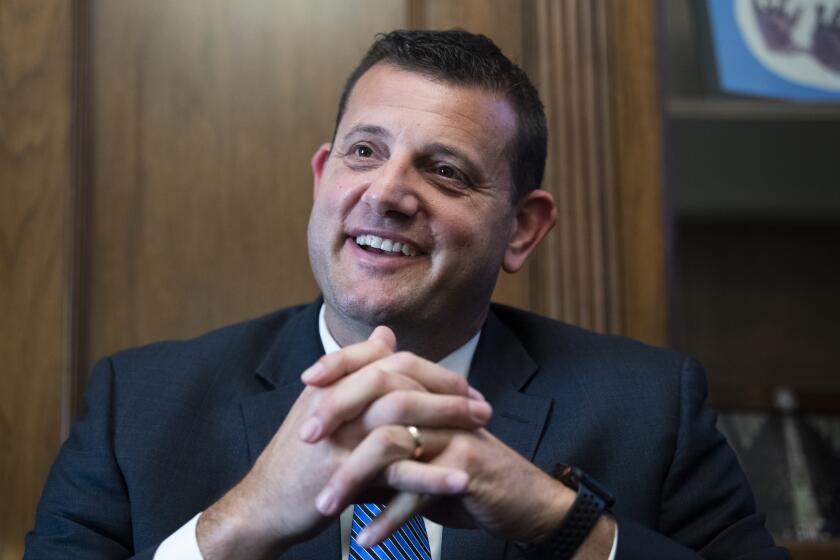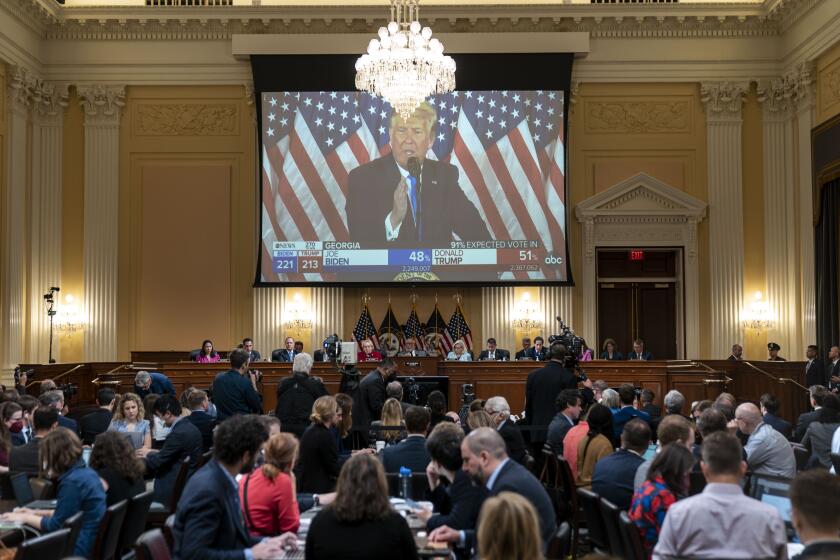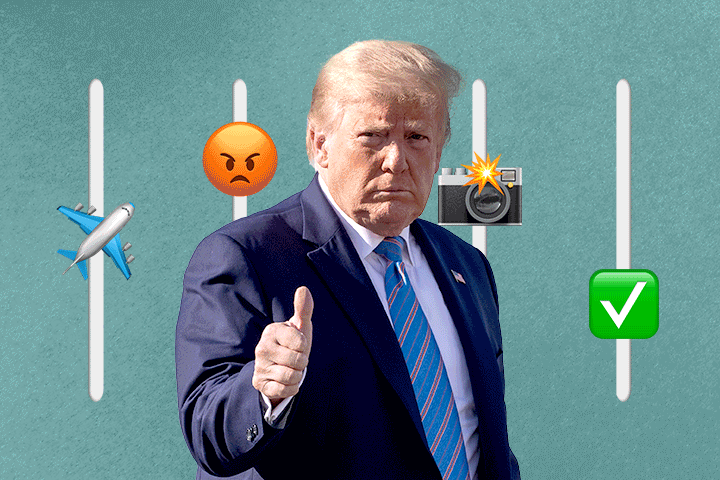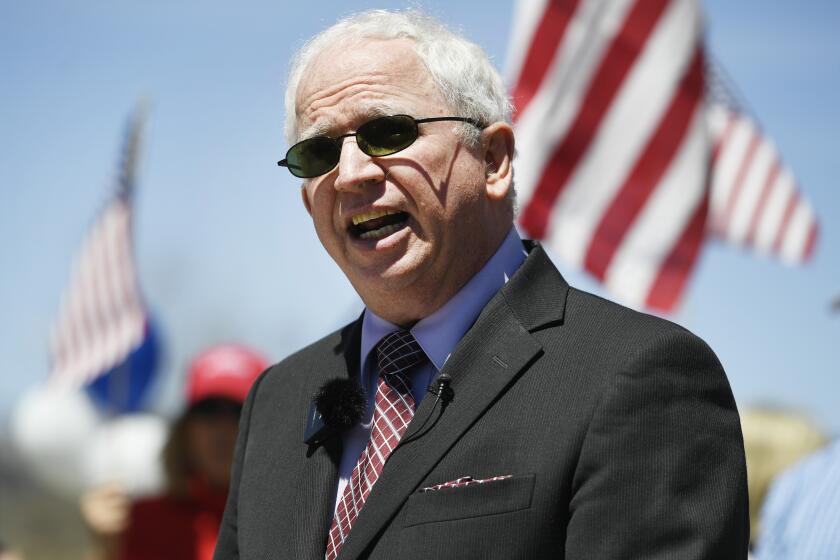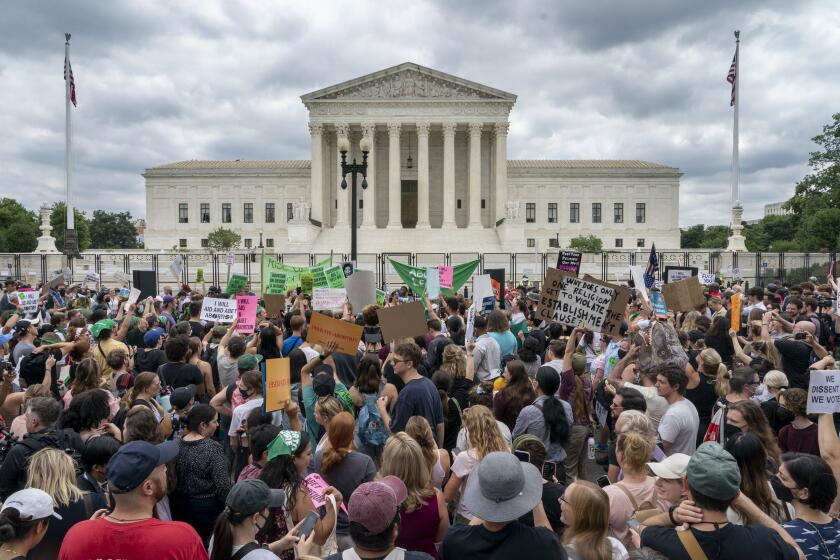GOP slightly edges Democrats on party switchers, study suggests
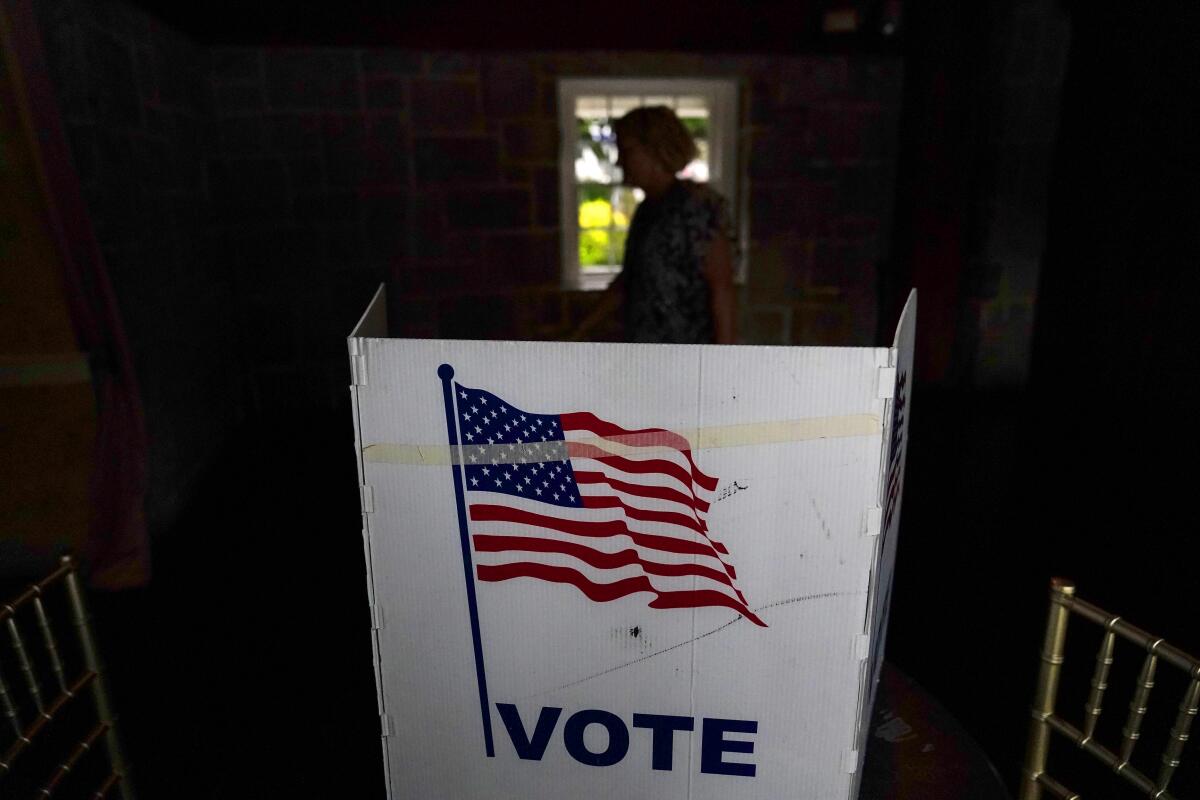
- Share via
WASHINGTON — A political shift is beginning to take hold across the U.S. as tens of thousands of suburban swing voters who helped fuel the Democratic Party’s gains in recent years are becoming Republicans.
More than 1 million voters across 43 states have switched to the Republican Party over the last year, according to voter registration data analyzed by the Associated Press. The previously unreported number reflects a phenomenon that is playing out in virtually every region of the country — Democratic and Republican states along with cities and small towns — in the period since Joe Biden succeeded Donald Trump as president.
Nowhere is the shift more pronounced — and dangerous for Democrats — than in the suburbs, where well-educated swing voters who turned against Trump’s Republican Party in recent years appear to be swinging back. Over the last year, far more people are switching to the GOP across suburban counties in areas such as Denver, Atlanta, Pittsburgh and Cleveland. Republicans also gained ground in counties around medium-size cities such as Harrisburg, Pa.; Raleigh, N.C.; Augusta, Ga.; and Des Moines.
Ben Smith, who lives in suburban Larimer County, Colo., north of Denver, said he reluctantly registered as a Republican earlier in the year after becoming increasingly concerned about the Democrats’ support in some places for mandatory COVID-19 vaccinations, the party’s inability to quell violent crime and its frequent focus on racial justice.
“It’s more so a rejection of the left than embracing the right,” said Smith, a 37-year-old professional counselor whose transition away from the Democratic Party began five or six years ago when he registered as Libertarian.
The AP examined nearly 1.7 million voters who had likely switched affiliations across 42 states for which there are data over the last 12 months, according to L2, a political data firm. L2 uses a combination of state voter records and statistical modeling to determine party affiliation. While party switching is not uncommon, the data show a definite reversal from the period while Trump was in office, when Democrats enjoyed a slight edge in the number of party switchers nationwide.
Republican Rep. Valadao, who voted to impeach Trump, survives California primary but faces a blue district in the November election. Jan Perry advances in L.A.
But over the last year, roughly two-thirds of the 1.7 million voters who changed their party affiliation shifted to the Republican Party. In all, more than 1 million people became Republicans compared with about 630,000 who became Democrats.
The broad migration of more than 1 million voters, a small portion of the overall U.S. electorate, does not ensure widespread Republican success in the November midterm elections, which will determine control of Congress and dozens of governorships. Democrats are hoping that the Supreme Court’s decision Friday to overturn Roe vs. Wade will energize supporters, particularly in the suburbs, ahead of the midterms.
Still, the details about party switchers present a dire warning for Democrats who were already concerned about the factors that will help shape the political landscape this fall.
Roughly four months before election day, Democrats have no clear strategy to address Biden’s weak popularity and voters’ overwhelming fear that the country is headed in the wrong direction with their party in charge. And while Republicans have offered few policy solutions of their own, the GOP has been working effectively to capitalize on the Democrats’ shortcomings.
The Jan. 6 hearings have already shown the public there are least three potential criminal charges Atty. Gen. Merrick Garland could prosecute Trump on.
Republicans benefited last year as suburban parents grew increasingly frustrated with prolonged pandemic-related schools closures. And as inflation intensifies, the Republican National Committee has been hosting voter registration events at gas stations in suburban areas across swing states such as Arizona, Michigan, Nevada and Pennsylvania to link the Biden administration to record-high gas prices. The GOP has also linked Biden to an ongoing baby formula shortage.
“Biden and Democrats are woefully out of touch with the American people, and that’s why voters are flocking to the Republican Party in droves,” RNC Chair Ronna McDaniel told the AP. She predicted that “American suburbs will trend red for cycles to come” because of “Biden’s gas hike, the open border crisis, baby formula shortage and rising crime.”
The Democratic National Committee declined to comment when asked about the recent surge in voters switching to the GOP.
And while Republican officials are quick to take credit for the shift, the phenomenon gained momentum shortly after Trump left the White House. Still, the specific reason or reasons for the shift remain unclear.
Get our L.A. Times Politics newsletter
The latest news, analysis and insights from our politics team.
You may occasionally receive promotional content from the Los Angeles Times.
At least some of the newly registered Republicans are actually Democrats who crossed over to vote against Trump-backed candidates in GOP primaries. Such voters are likely to vote Democratic again this November.
But the scope and breadth of the party-switching suggests something much bigger at play.
Over the last year, nearly every state — even those without high-profile Republican primaries — moved in the same direction as voters by the thousands became Republicans. Only Virginia, which held off-year elections in 2021, saw Democrats notably trending up over the last year. But even there, Democrats were wiped out in last fall’s statewide elections.
In Iowa, Democrats used to hold the advantage in party changers by a 2-to-1 margin. That’s flipped over the last year, with Republicans ahead by a similar amount. The same dramatic shift is playing out in Ohio.
Former President Trump uses primary endorsements to seek revenge, push election fraud lies and shape the Republican Party. How are his candidates faring?
In Florida, Republicans captured 58% of party switchers during those last years of the Trump era. Now, over the last year, they command 70%. And in Pennsylvania, the Republicans went from 58% to 63% of party changers.
The current advantage for Republicans among party changers is playing out with particular ferocity in the nation’s suburbs.
The AP found that the Republican advantage was larger in suburban “fringe” counties, based on classifications from the Centers for Disease Control and Prevention, compared with smaller towns and counties. Republicans boosted their share of party changers in 168 of 235 suburban counties AP examined — 72% — over the last year, compared with the last years of the Trump era.
These included suburban counties across Georgia, Iowa, North Carolina, Pennsylvania, Tennessee, Texas, Ohio, Virginia and Washington state.
The Jan. 6 investigation marks the confluence of key figures and influences in Eastman’s life, including his decades in California’s political scene.
Republicans also gained ground in further-out suburban counties, which the CDC lumps in with medium-size cities and calls “medium metro”; more than 62% of such counties, 164 in all, saw Republican growth. They range from the suburban counties north of Denver, like Larimer, to Los Angeles-area ones like Ventura and Santa Barbara.
Some conservative leaders worry that the GOP’s suburban gains will be limited if Republicans don’t do a better job explaining to suburban voters what they stand for — instead of what they stand against.
Emily Seidel, who leads the organization Americans for Prosperity, said her network is seeing first-hand that suburban voters are distancing themselves from Democrats who represent “extreme policy positions.”
“But that doesn’t mean that they’re ready to vote against those lawmakers either. Frankly, they’re skeptical of both options that they have,” Seidel said. “The lesson here: Candidates have to make their case, they have to give voters something to be for, not just something to be against.”
On abortion, guns and religion, the court is giving its Republican sponsors what they hoped for.
Back in Larimer County, Colo., 39-year-old homemaker Jessica Kroells says she can no longer vote for Democrats, despite being a reliable Democratic voter up until 2016.
There was not a single “aha moment” that convinced her to switch, but by 2020, the Democratic Party had “left me behind,” she said.
“The party itself is no longer Democrat — it’s progressive socialism,” she said, specifically condemning Biden’s plan to eliminate billions of dollars in student debt.
More to Read
Sign up for Essential California
The most important California stories and recommendations in your inbox every morning.
You may occasionally receive promotional content from the Los Angeles Times.
